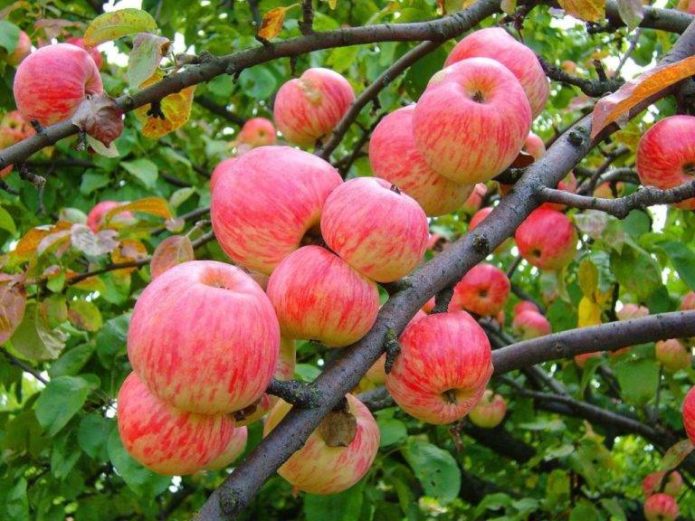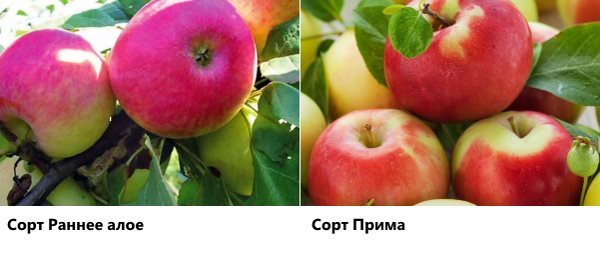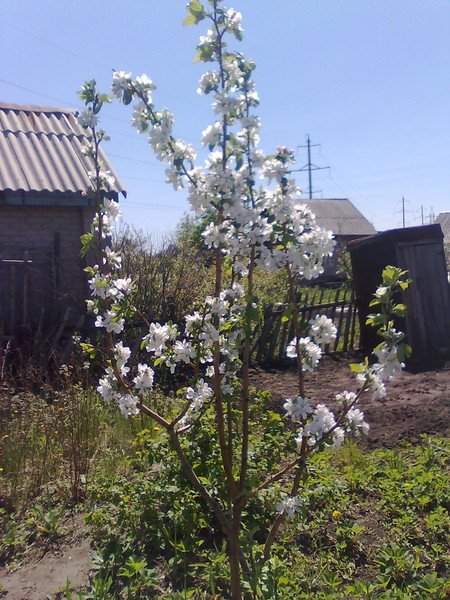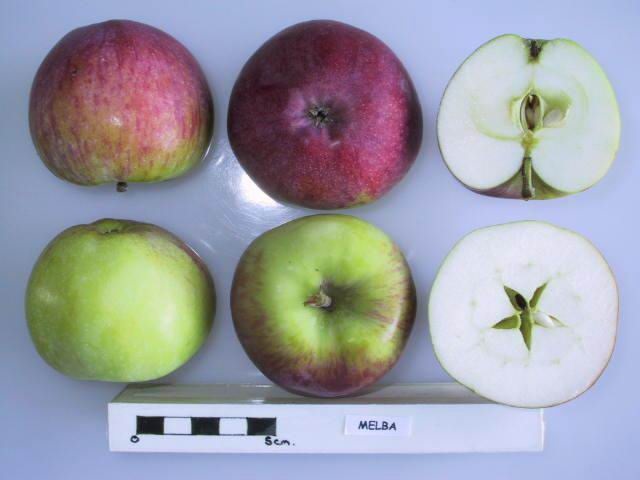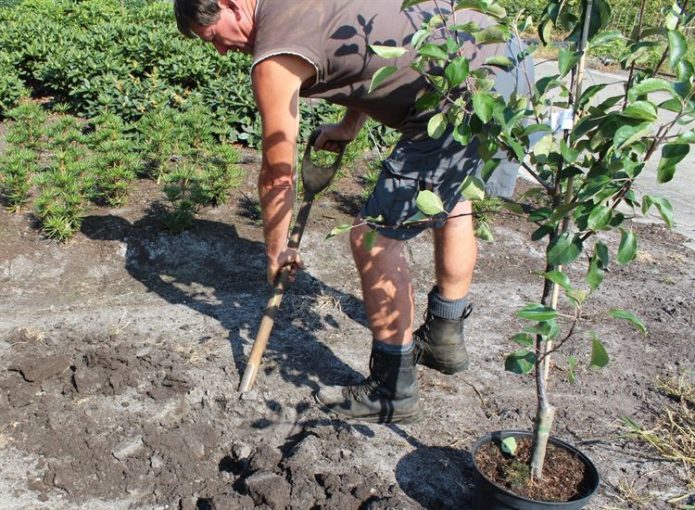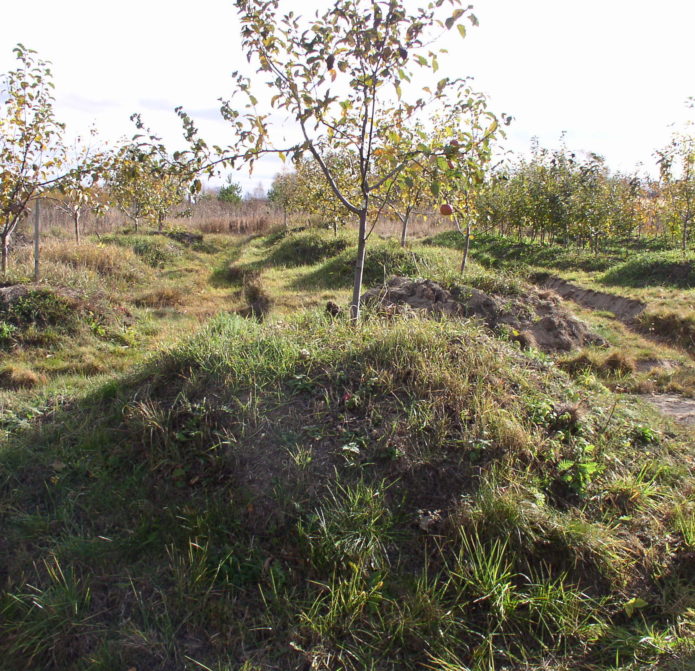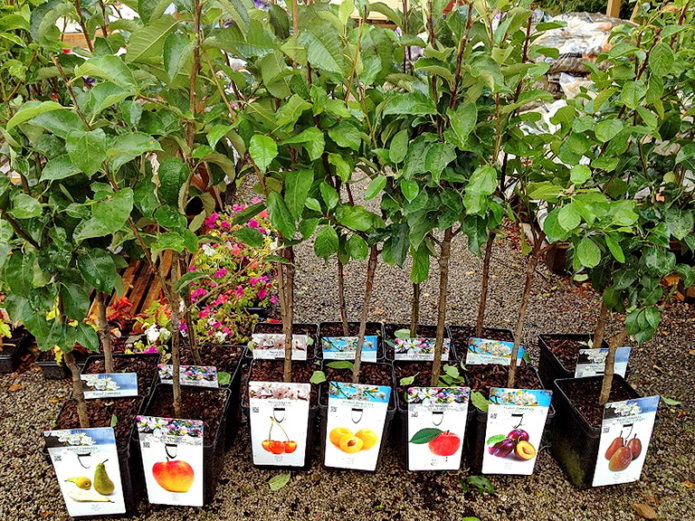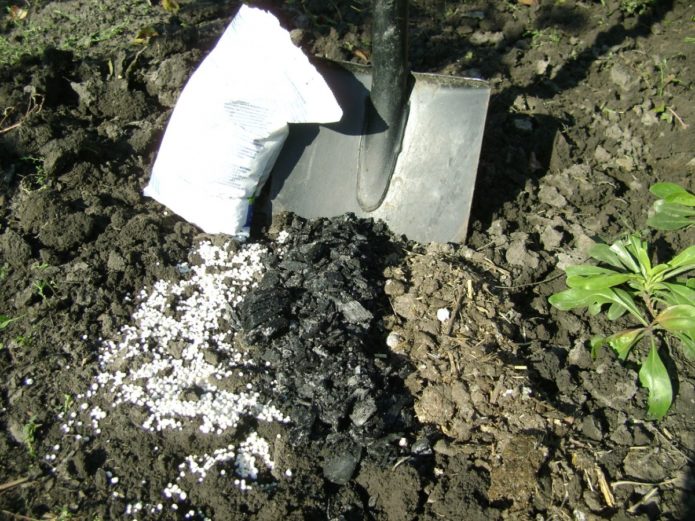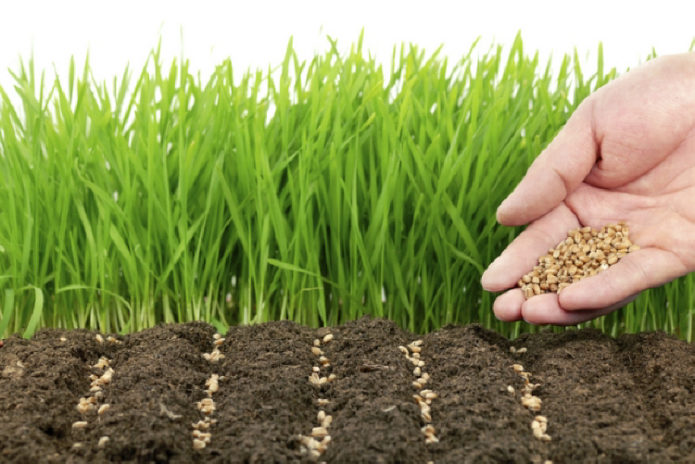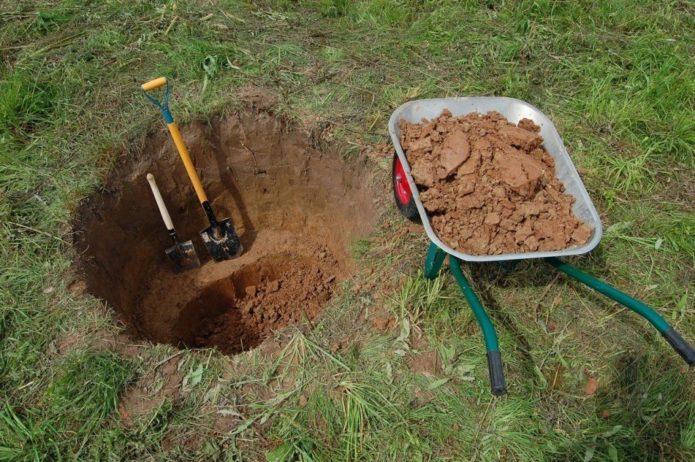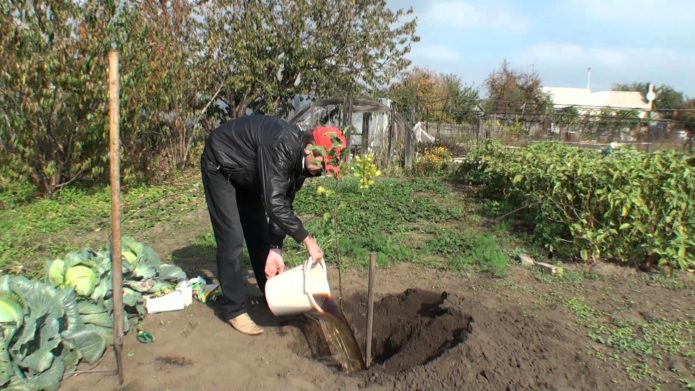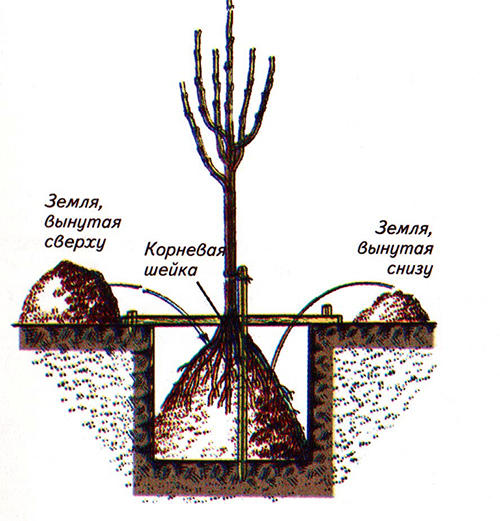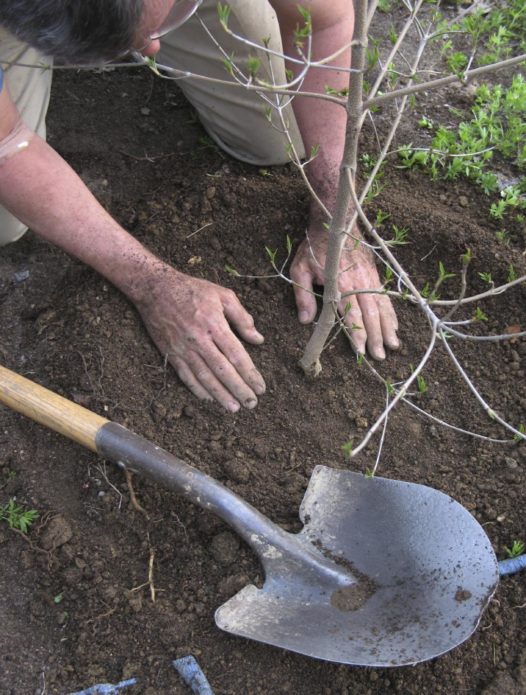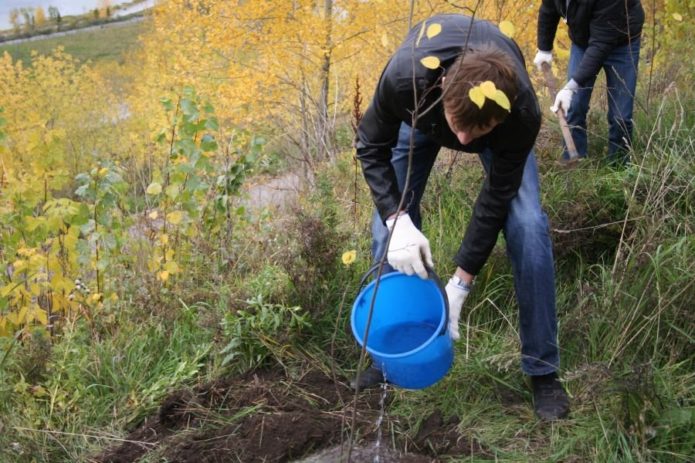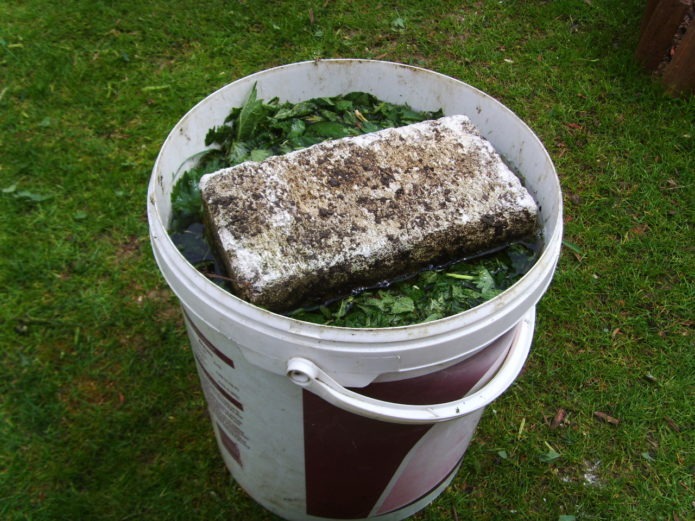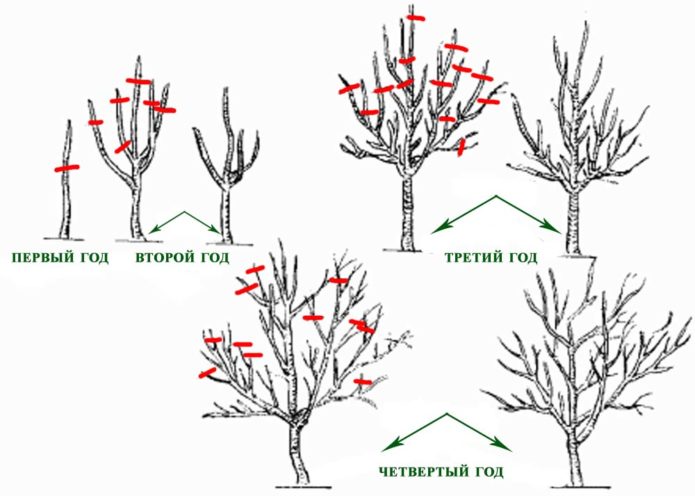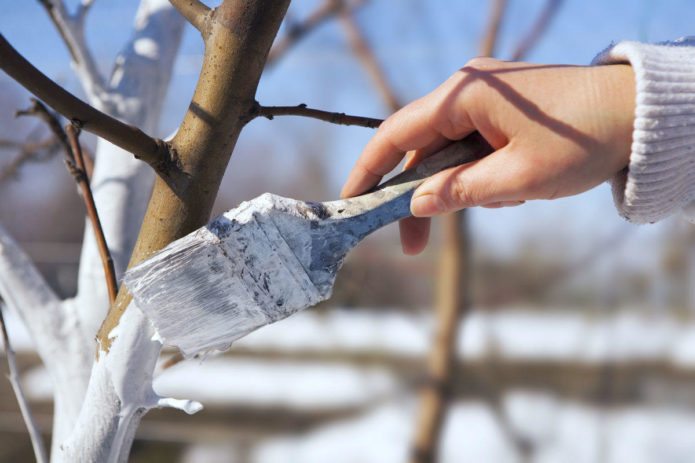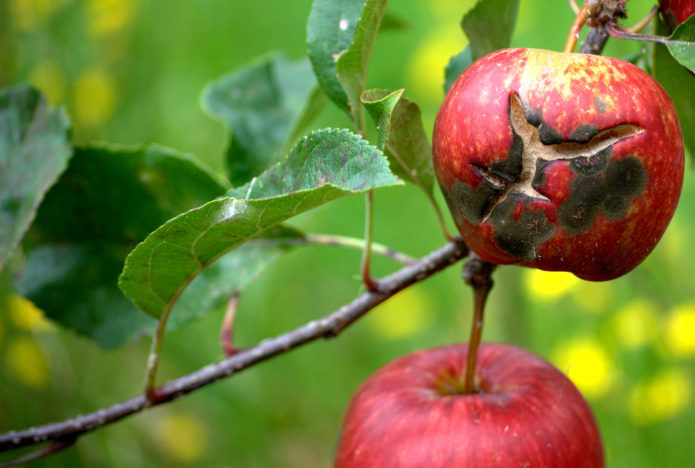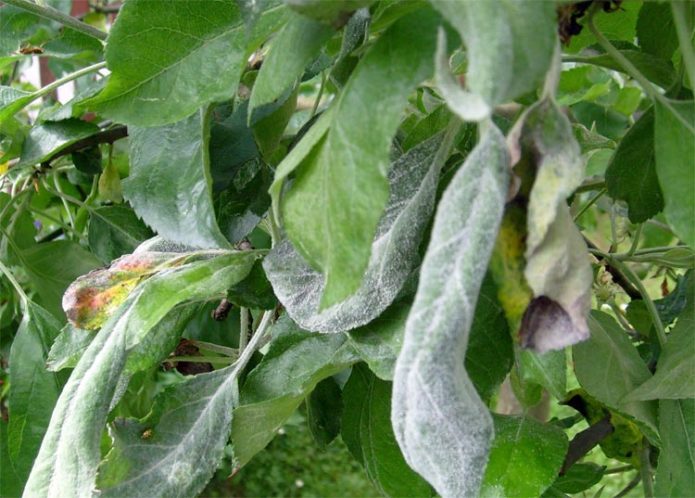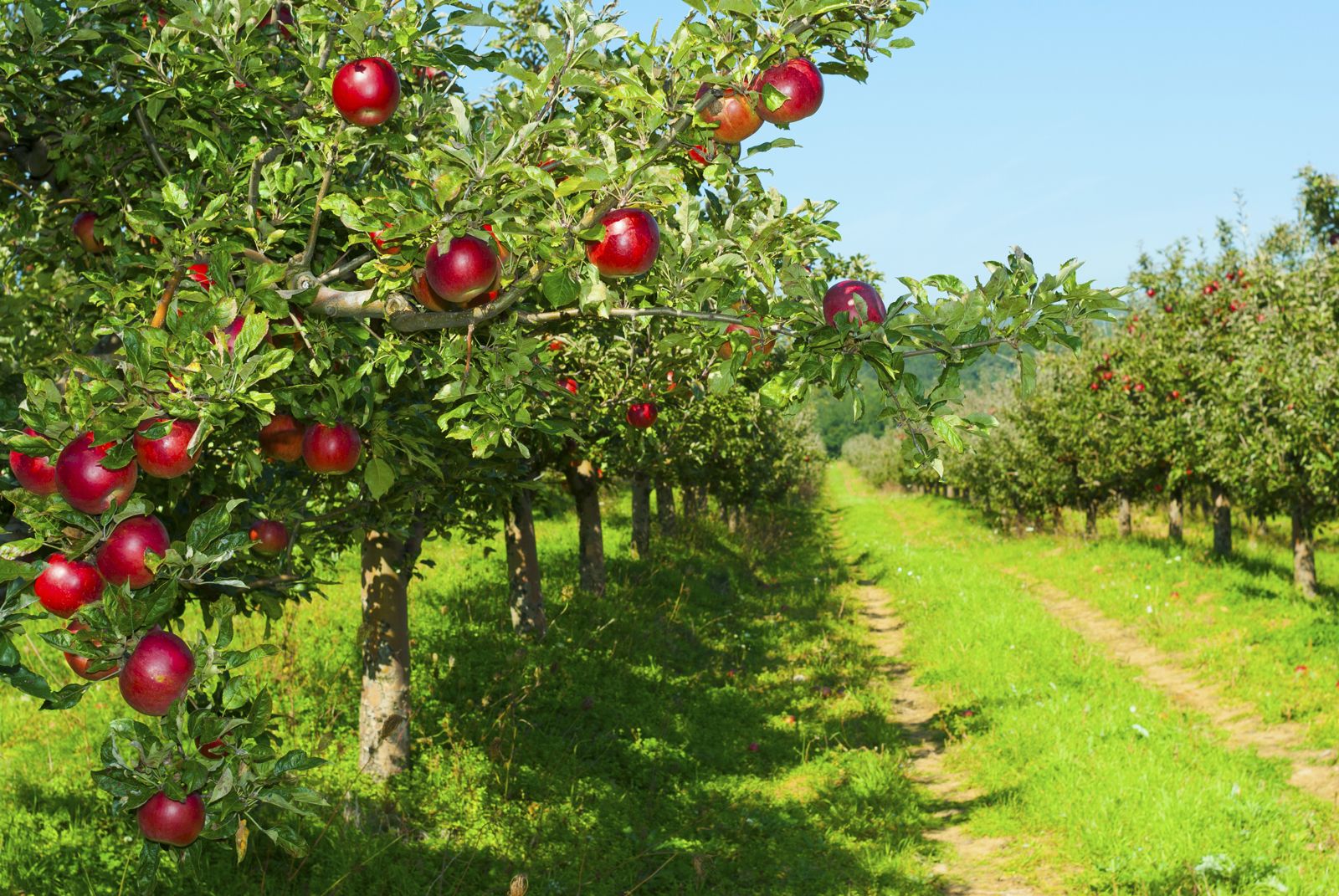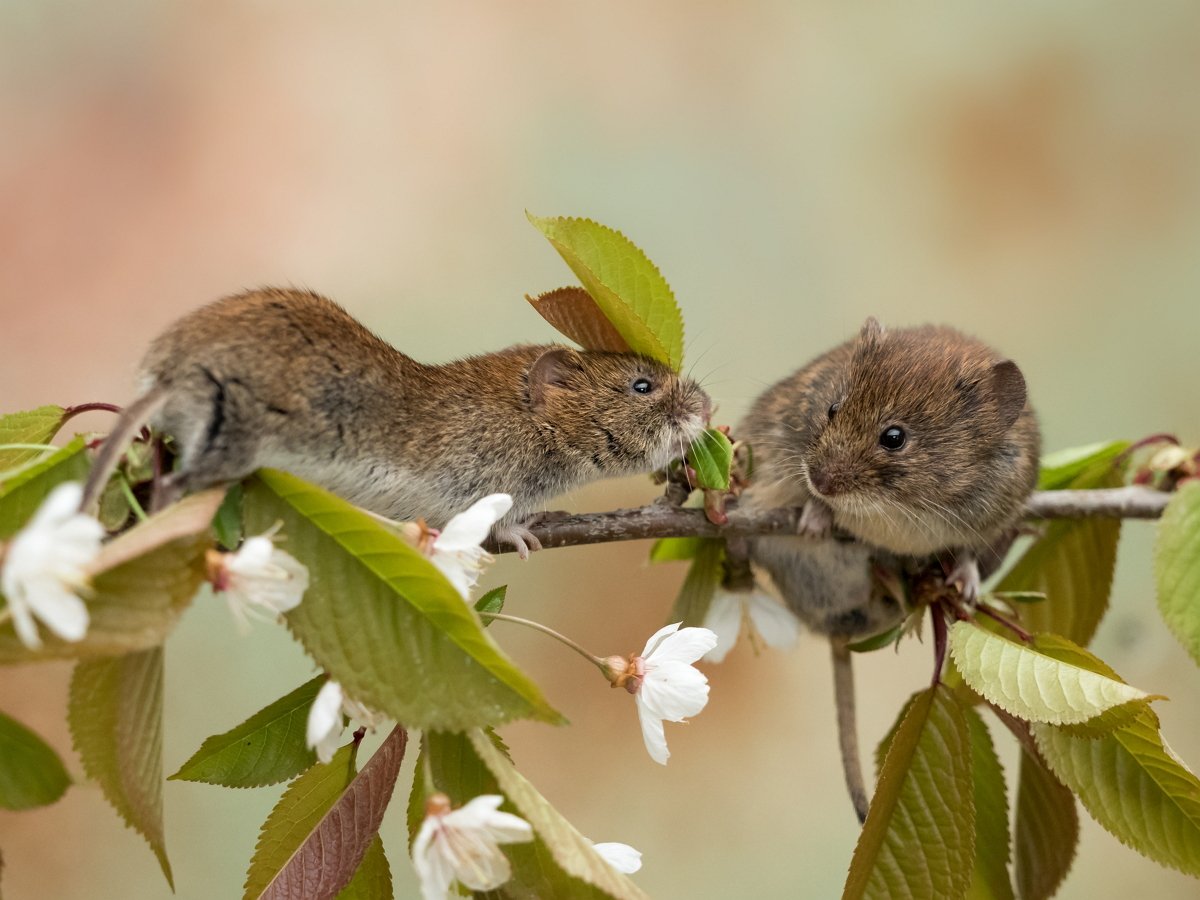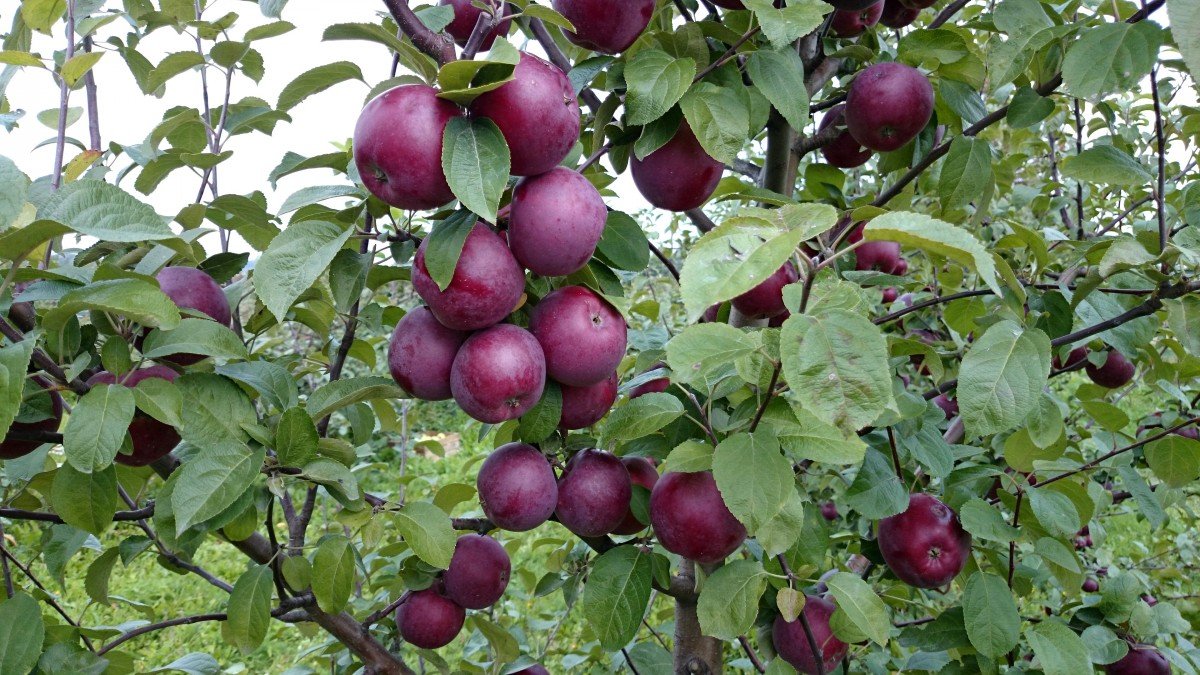The Melba apple variety can be called unique. The long history has in no way affected its popularity. On the contrary, interest only grows. Canadian breeders need to thank for this miracle: it was through their efforts that unusually tasty and aromatic apples appeared, so beloved by consumers and gardeners from almost the whole world.
Content
History of the Melba apple variety
In almost any garden in Russia, you can find the Melba apple variety. This culture has been cultivated for more than a dozen years, and interest in it is not waning. What is the secret of such popularity?
The history of the variety began back in 1898 in Canada. At the central experimental station in Ottawa, by free pollination of the Macintosh apple tree, a seedling appeared, which received an excellent assessment at home. Due to its high taste and excellent characteristics, Melba soon found itself in the gardens of Europe, and then in Russia, where it also showed excellent results. For its positive qualities in 1947, the Melba apple tree was included in the State Register of Breeding Achievements of the Russian Federation and zoned in almost all regions of Russia:
- Central;
- Northwest;
- Volgo-Vyatsky;
- Central Black Earth;
- North Caucasian;
- Middle Volga;
- Nizhnevolzhsky;
- West Siberian;
- East Siberian.
The variety got its name in honor of the Australian opera singer Nelly Melba. In the literature, the spelling of the variety as Melba is often found. However, few people know that the apple tree has one more name, however, not so popular - Azure.
Varieties
Melba is not only a great example of taste. It is also an excellent material for creating new varieties of the variety - with her participation, more than 20 varieties were born. Breeders of Russia, Canada and the USA showed the horticultural world such varieties and clones of Melba:
- Early scarlet;
- Cherished;
- Prima;
- Caravel;
- Melba's daughter;
- Melba Red.
What does the Melba apple tree and fruits look like?
The Melba tree is medium in size - an adult apple tree reaches 3 meters in height. There are also varieties on a dwarf rootstock with a height of only 1.8–2 m. The spreading and raised crown has a wide-rounded shape and medium foliage. The color of the bark is dark - orange-brown. The culture is characterized by a mixed type of fruiting, but in adulthood, the crop is formed mainly on annelids (these are short (up to 3 cm) shoots with underdeveloped lateral buds, which grow with age, branch out and form fruit buds at the ends).
A characteristic feature of the variety is the fact that, before entering the fruiting period, a young apple tree rather resembles a columnar plant: the trunk is straight and thick, the shoots are slightly pressed against it and stretch up. The spreading of the crown appears only over time.
The foliage is light green, sometimes the main color dilutes the yellowish tint. The leaf is oval-oblong, with a crenate edge and a slight bend. On annual seedlings, the edges of the leaf plates hang down. In adult apple trees, the leaves growing on strong shoots, as it were, bulge upward, become convex.
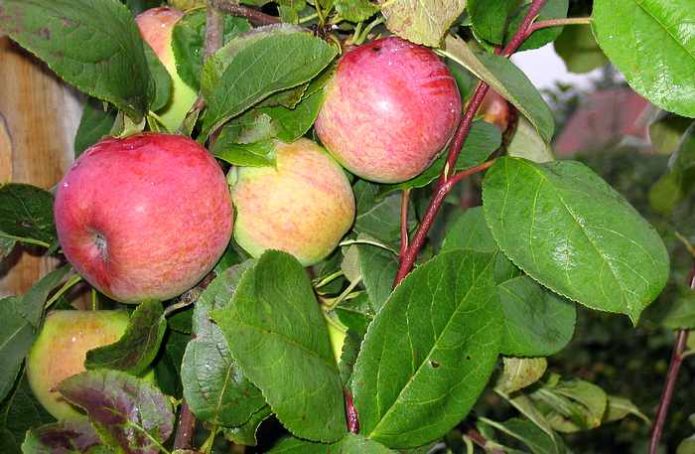
The shape of the light green leaves of the Melba apple tree is oval-oblong, with a crenate edge and a slight bend
The flower buds, ready to open, are pink-white with a purple tint. The flowers are large, with round light pink petals, which are very tight, almost overlapping, adjacent to each other. Blooming Melba fills the air with a wonderful scent.
Round-conical fruits of regular shape are of medium size. The usual weight of an apple is 120–140 g, sometimes 300 g. The surface is smooth or slightly ribbed. The skin, although dense, but not rough, is oily to the touch due to a waxy white-gray bloom. The main color is white-green, in a ripe fruit it is greenish-yellow. An overlying bright red striped blush can take up half an apple. The points under the skin are numerous, small or medium-sized, white, well distinguishable. Seeds are oblong, large, brown.
Under the bright skin lies an almost snow-white pulp, tender and juicy. It has a wonderful sweet and sour taste with caramel notes. In general, Melba is considered to be the standard of apple taste. The aroma of the fruit is bright, candy. Tasters estimate the taste of the variety very high - from 4.4 to 5 points.
Variety characteristic
- Melba is a variety of medium early maturity: with proper care, apple trees grafted onto dwarf rootstocks begin to bear fruit as early as 3-4 years; trees on vigorous rootstocks - for 4–5 years;
- the yield of the apple tree is very high. In private gardens, one adult tree bears from 50 to almost 90 kg of fruit. In industrial plantings, the yield is 90–160 c / ha. But Melba has one peculiarity. Young apple trees are able to bear fruit abundantly and steadily up to 8–10 years of age, but in an adult tree, the frequency of fruiting is traced - once every two to three years;
- the harvest ripens in late summer, starting in the second half of August. But cool weather can extend the ripening process until mid-September;
- overripe fruits are prone to shedding, so it is recommended to pick them a few days before full ripeness. In this form, apples can be stored for 1 or 2 months;
- another advantage of Melba is the excellent transportability of the fruit. It is this feature and the excellent appearance of apples that attracts those who are engaged in the cultivation of fruits for sale;
- the apple tree is relatively frost-resistant, has above average winter hardiness. But in regions with a harsh climate, the bark of the trunk and branches may suffer from frost cracks (these are cracks that appear along the fibers or throughout the entire tree trunk in severe frosts). Therefore, in Siberia, an apple tree is formed in a stale (creeping) form, which helps to hide the tree under any covering material;
- poor scab resistance is noted. In those years when summers are cold and rainy, Melba can be seriously affected by this disease;
- to increase yields and improve the quality of fruits, pollinators should be planted in a pair to Melba. Old and proven varieties - Antonovka and Borovinka - perfectly cope with this task;
- ripe apples are versatile in use. Fresh fruits will strengthen health and delight with taste.And also Melba apples are perfect for preservation. Thick jam, aromatic jam, sweet juice and compote - all these preparations contain fiber, vitamins and other useful substances, which, if properly processed, can be preserved even in a processed product.
Video: Melba apple tree
Landing conditions
In order for a seedling to take root in a new place, you need to know the climatic features of your region. After all, only on time and according to the rules, a planted tree can please with its rapid growth.
Landing dates
Since Melba can be grown in almost any region of our vast country, therefore, planting dates in different parts of it do not coincide.
For warm regions and areas with a temperate climate, autumn planting is suitable. It is good in that a favorable combination of soft autumn and rainfall will help the seedling quickly acquire absorbent roots.
Young apple trees are actively planted from mid-September to mid-October, when the leaf fall begins, indicating that the apple tree is sinking into a dormant period.
In Crimea, a later landing is also appropriate, as the weather is fine. The main factors of autumn planting:
- the seedling should stop the growth activity of the shoots, thus, all the strength of the plant will be given to the process of growing roots;
- for the rooting process to be successful, the soil temperature should not fall below +4 ° С;
- planting is best done in the second half of the day, this will allow you to plant the seedling in warm soil.
In order for a young apple tree to take root before the cold weather in such conditions, it needs a little time - 2-3 weeks.
Spring planting in central Russia occurs from late March to early April. The main thing is to plant the apple tree at a time when its buds have not yet begun to bloom, otherwise the rooting process may be protracted.
In Siberia, on the contrary, there is no need to rush. Usually, in places with a harsh climate, planting is carried out in early May, when the possible threat of spring return frosts will come to naught.
Few know, but Melba can be planted in summer. To do this, you need to purchase seedlings with a closed root system.
Site selection, suitable soil
In order for the apples to be of excellent quality - ruddy and sweet, the tree should be planted only in well-lit places. The site must be protected from drafts and piercing winter winds, especially in cold regions, since, although Melba has an above average winter hardiness, its trunk and branches can crack in severe frosts with wind.
However, it is not worth depriving the apple tree of the necessary easy airflow of the crown, this can provoke the development of a fungal infection.
In regions where the climate is harsh and unpredictable, Melba can be planted near the southern or southeastern side of a house or farm building. When heated by the sun's rays, the stone surface will give off heat to the plant and soil.
Melba is unpretentious, but still prefers fertile lands. Light and loose loams, fertile chernozems, dark chestnut soils, rich in humus, are perfect for planting and further growth.
One of the factors for the successful cultivation of Melba is the low occurrence of groundwater - no closer than 1.5 m to the soil surface. In flooded and wetland areas for planting seedlings, artificial hills (up to 50 cm) and diverting grooves are built, which help to quickly drain the problem area.
Sapling selection
The further fate of the apple tree will depend on the right choice: there will be no sense from a frail and sick planting material. Therefore, approach the selection of a seedling responsibly and pay attention to the following:
- the age of the seedling is 1–2 years.This age category has the best survival rates;
- the trunk is thick, even, without signs of damage;
- the root system is developed, with several main roots covered with a mesh of absorbent roots;
- the presence of a vaccination will tell you that this is a grafted plant, not a wild one.
If you buy a seedling in the spring, then do not be too lazy to check if the wood is alive. To do this, make a small incision on the trunk. If the wood underneath is green, then everything is in order. A brown color indicates a problem - most likely, the seedling did not survive the winter.
In order not to be mistaken with the choice (since the variety is very popular, unscrupulous sellers can sell another under the guise of Melba) and purchase a zoned and healthy Melba apple tree sapling, contact only trusted sellers or special horticultural centers.
Site preparation
Prepare the site in advance. It often happens that, in the absence of an extra free piece of land in place of an old tree or shrub culture, we plan to plant a new tree. But the previous resident had already depleted the soil, took all the nutrients from it. Therefore, before planting an apple tree, prepare the soil, increase its fertility level and let it rest a little. To do this, do the following:
- A year before planting, free the intended area from the remnants of previous vegetation, stones, perennial roots.
- Spread the following fertilizers evenly over the surface of the ground, which will then fall into the soil during deep digging. Rate for 1 m²:
- 10–20 kg of rotted manure or compost;
- 15 g of nitrogen-containing fertilizers;
- 25 g superphosphate.
- If you carry out such preparation in the fall, then do not break the clods of earth, they will help to keep the snow cover on the site and by spring they will disintegrate.
- You can sow the site with siderates, and dig them up in the fall. Organic matter will help the soil to acquire a porous structure and replenish nutrient stores.
If the soil in your area is acidic, take care to bring the indicators to neutral. To do this, add fluff lime or dolomite flour (up to 500 g per 1 m²) to the fertilizers for digging.
Also take care of the landing pit in advance. For an autumn planting, dig up and fill the hole with a nutrient mixture at least a month in advance. Prepare for the spring procedure in the fall. The procedure is as follows:
- Dig a hole 70–80 cm deep and wide. If the soil was not cultivated before planting or if the soil on the site is dense, clayey, increase the depth to 1 m.
- Set the top fertile layer aside. Scatter the soil raised from the depths in the garden.
- Add nutrients to the deposited soil: 1–2 buckets of rotted humus (add 3–4 buckets on an untreated area); 50–80 g of any potash fertilizers; from 100 to 200 g of superphosphate.
- Drive a stake into the bottom of the hole, which will serve as a support for the seedling.
- Mix the fertilizers with the soil and pour into the pit. If there is not enough soil to fill the groove to the brim, add garden soil.
- To help the soil settle and the nutrients to dissolve, pour 2 buckets of water into the pit.
Video: how to properly prepare a seat for an apple tree
Scheme and order of landing
To prevent the apple tree from growing in dense shade, follow two schemes:
- a proven option is a compacted scheme - 6/3 m;
- using a 7/7 m pattern, you can use row spacings for growing vegetables before Melba gets too big.
In due time, having purchased a Melba apple tree sapling, start planting. It is better to spend it together.The process consists of the following steps:
- Remove part of the soil from the prepared hole, form the rest at the bottom in the form of a slide.
- Place the seedling in the center, straighten the roots - they should lie freely, without kinks and twists.
- While one gardener holds the seedling in place, the second, with the help of a shovel, fills the hole and roots with the soil mixture removed.
- When the hole is full, compact the soil, and tie the seedling to a support.
- In a properly planted plant, the root collar should be 5-7 cm higher than the planting level.
- Form a watering circle around the seedling at a distance of 40-50 cm from the trunk and pour 2 buckets of water into it.
- When the moisture has been absorbed, cover the circle with peat or dry grass.
Be sure to plant pollinating varieties next to Melba's seedling, which were discussed in the section "Characteristics of the variety", since, although this variety is self-fertile, the harvest without pollinators will be worse.
Features of growing and care
In order for the Melba apple tree to delight with delicious fruits, the tree needs proper care. However, growing a young tree and caring for an adult is very different.
How to water
Adult Melba does not tolerate excess moisture, so water infrequently, but abundantly, so that the water saturates the soil to a depth of 40-50 cm. In the conditions of central Russia, watering is usually carried out once a month, pouring 60–70 liters of water under one tree.
On sandy soils, watering is carried out more often and more abundantly, on clay soils, on the contrary, the amount of water is slightly reduced. If the winter was rich in snow, then in early spring you can do without watering, since the soil is sufficiently saturated with thawed moisture. And if the spring is hot and dry, then watering is necessary. Do not miss the necessary hydration after flowering and at the time of fruit formation.
Saplings are watered a little differently:
- a young plant needs moisture for successful rooting. If the landing took place in the fall, then look at the weather. Usually, autumn precipitation is enough to give up additional moisture. But if the weather is dry, then 2 weeks after planting, water the seedling again;
- if the planting was in spring, then watering is carried out weekly, pouring 1-2 buckets of water under the seedling. Successful rooting, which will be accompanied by active growth of shoots, will tell you that the frequency of watering can be halved.
Helpful hints:
- try to water the seedlings only with warm water. To do this, you do not need to specially heat it, just leave the buckets in the sun for a couple of hours;
- watering a mature tree requires a lot of moisture. If you pour out all the water in one go, then a real swamp forms on the soil surface. Therefore, divide one application of moisture into 2 doses - morning and evening;
- the day after watering, lightly loosen it in the trunk circle. By breaking up the soil crust, you will restore soil aeration;
- if the weather forecast promises an imminent cooling, and no precipitation has fallen, it is necessary to irrigate before winter with more water (50–100 liters per tree);
- the watering circle increases with age. It is equal to the perimeter of the crown.
What fertilizers does the Melba apple tree prefer?
Melba is incredibly responsive to organic matter, which is good news for lovers of natural farming, but mineral fertilizers are still indispensable.
If nutrients were introduced during planting, then they begin to feed the apple tree only from the second year of development. During the growing season, 3 additional dressings are required:
- in the spring, while the apple tree has not bloomed, evenly scatter 1-2 buckets of humus, 1 glass of wood ash and 2 tablespoons of superphosphate in a circle near the trunk.Then carefully dig up the soil;
- in the summer, give preference to natural dressing. You can use a solution of 1/10 mullein or 1/20 chicken manure. Don't forget about green fertilizer, which is easy to make from nettle:
- the crushed plant is placed in a container and poured with water - for 1 part of the raw material, 2 parts of the liquid;
- closed with a lid and left in an open place for 3-4 days;
- after filtering. For 1 tree, you will need 1 bucket of any of the listed solutions.
- in the fall, after the harvest is fully harvested, it's time to prepare the apple tree for the onset of winter. To make the wood ripen before the cold weather comes, use potash fertilizers (50–70 g per tree) and compost.
Pruning
Pruning is another important step in grooming. The seedling must necessarily undergo a crown formation procedure, which is usually given a sparse-tiered shape.
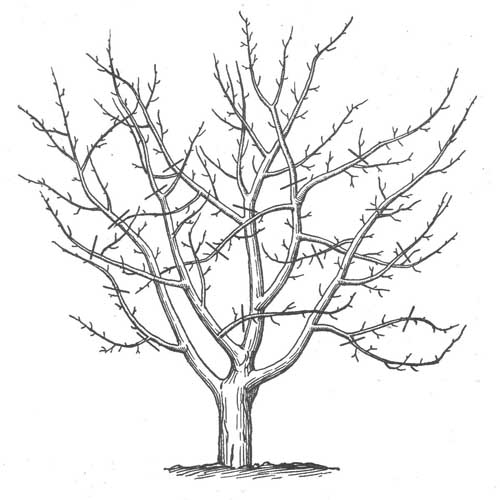
The crown of an apple tree seedling, including the Melba varieties, is usually given a sparse-tiered shape
This process usually takes about 4–5 years. Formation is carried out in early spring, before the start of sap flow, thus:
- In the spring, an annual tree is crowned (cut off the central shoot) at a height of 80 cm.
- The stem is formed at a distance of 50 cm from the soil surface, for this you need to remove all the shoots in this area. From the remaining buds, shoots will develop, which next year will serve as the basis for laying a tier.
- In the second year, 3 developed shoots are chosen that do not grow from adjacent buds. Shorten them at the same level (about 1/3). This will be the first tier. The central conductor is cut so that it rises 15–20 cm above the branches of the first tier. The remaining shoots are cut into a ring.
- In the third spring, a second tier is formed in a similar way, in which up to 2 branches are left, growing 50 cm higher than the first skeletal ones.
- At the beginning of the next season, another layer is laid.
As already noted, in cold regions, preference is given to the creeping shape of the crown of the Melba apple tree. It allows not only to protect the tree from strong winds, but also to cover it in case of severe frosts.
When the formation is completed, the turn of the following types of pruning comes, which have different purposes and terms:
- thinning - helps to clear the crown from the curves that have grown during the growing season, weak, growing downward or inside the crown of the shoots. It is carried out in the spring, before the buds begin to bloom;
- sanitary - carried out as necessary if the branches of the apple tree are damaged by a disease. For the Melba variety, this type of pruning is especially relevant due to the tendency to scab: in order to avoid further infection, it is urgent to remove and destroy branches and shoots, the leaves and fruits on which are too infected or have already died;
- anti-aging - carried out to spur the fading processes of shoot growth and fruiting. It can be done in the fall, until the temperature has dropped below –5 ° C, or in the spring, before the buds swell.
Video: how to prune an old and neglected tree
Winter protection
In October, you need to prepare the apple tree for the winter period:
- A thorough inspection is required first.
- After it, you should cut off the broken or dried branches, clean off the old peeled bark.
- Then you need to whitewash the tree trunks.
- Last but not least, it is necessary to carry out top dressing, water charging and treatment from diseases and pests.
In warm regions, it is enough to insulate the root zone with a thick layer of mulch. In cold weather alone, such protection may not be enough. So that the bark of the trunk and skeletal branches does not suffer from frost, insulate the apple tree with any material that allows air to pass through. The use of roofing material or cellophane film can result in rotting of the bark.
In a snowy winter, you can collect a large snowdrift around the apple tree. There is a double benefit from this natural shelter. In winter, the trunk will not freeze, and in spring, the melt water will properly saturate the roots with moisture and save you from watering.
Diseases and pests, control measures and prevention
The Melba apple tree does not resist well one of the most common stone fruit diseases - scab. Sometimes even good care does not save you from adverse weather conditions that can cause the onset and spread of infection. Therefore, carry out preventive examinations of the tree more often in order to identify disease or pests in time and take measures to combat them. Besides scab, Melba can suffer from powdery mildew.
Scab
The disease initially affects the foliage, manifesting itself on it in the form of brown spots. Then comes the turn of the fruits. Their surface becomes covered with dark spots, which increase in size, the affected tissue becomes like a cork, cracks. Apples stop growing, deform and can no longer be stored. Cold and damp weather contributes to the spread of the disease. Fungal spores are easily carried by wind and raindrops.
Disease prevention consists in proper agricultural technology. In the fall, you should dig up the trunk circle, removing all fallen leaves from its surface. Thinning pruning and whitewashing will help increase the resistance of the apple tree. Control measures:
- treatment with 1% Bordeaux liquid - carried out when the kidneys are in the green cone phase;
- spraying with Skor solution (2 ml per 10 l of water) on a pink bud;
- reprocessing after 2-3 weeks with changing the drug to Cyben or Kaptan (50 g per 10 l of water).
Powdery mildew
On the shoots and leaves, a white, flour-like coating appears almost simultaneously. As the disease progresses, the leaf deforms, its surface coarsens and dries. The fungus can also attack flowers and ovaries. A neglected disease reduces the frost resistance of the apple tree. Most often, an outbreak of the disease is provoked by too high air temperature. In order to prevent the development of powdery mildew, it is necessary to control watering, to prevent drying out and waterlogging of the soil, not to get carried away with nitrogen-containing fertilizers, but to give preference to phosphorus-potassium fertilizers - they increase the resistance of the apple tree. If a tree is infected, take the following measures:
- treat the apple tree three times with a solution of colloidal sulfur - 2% at the budding stage, 1% after flowering and 15–20 days after the second treatment;
- instead of colloidal sulfur, you can use Bordeaux liquid.
Apple moth
Of the pests for the apple tree, caterpillars of the apple moth are dangerous. After emerging from the cocoon, they begin to feed on the pulp of young foliage, biting into the buds. This leads to a loss of green mass and a slowdown in photosynthesis. As a result, the apple tree lags behind in development, and in winter it leaves unprepared, which adversely affects the level of winter hardiness. Prevention begins in the fall with digging the trunk circle and removing the old exfoliated bark from the apple tree. In the spring, pheromone traps are placed to catch moths. Control measures:
- paraffin-containing preparations (for example, Dimilin) are used to destroy the laying of eggs;
- the caterpillars are fought with Actellik or Inta-Vir solution.
Melba apple reviews
I think Melba is one of the tastiest, if not the most delicious, summer apples I know. I met many of her clones. I chose a very good one from one of my friends - a large, tasty, aromatic and not very sore-prone clone of this variety and planted it on the 118th rootstock. I believe that Melba should be in every garden where only it can grow.
Apple trees Lobo and Melba and bad weather do not care - they are ripe and delight us with their sweet, delicious apples.
Young Melba (4-year-old) in a sunny area has already been harvested and the fruits are eaten. Beautiful large delicious apples! On the second site, the apple tree is 12 years old. Was in the shade. The apples are hanging. Blush only at the top of the head. There are still many greens. And small ones. We are eating now.
Well, Melba is definitely freezing - to cut it out and spread it like a stanza - that is, to rejuvenate and hide it under the snow - it will immediately begin to bear fruit - with your already grown root system, then. Melba is one of the most delicious apple trees, that's why everyone is worn.
Growing the Melba apple tree is easy. The variety is unpretentious, easily adapts to various conditions. True, there are some nuances of care, the implementation of which will help to prolong fruiting and increase productivity. A little care - and your garden will be filled with the wonderful scent of blooming Melba, and then smelling with the unique aroma of its fruits.
